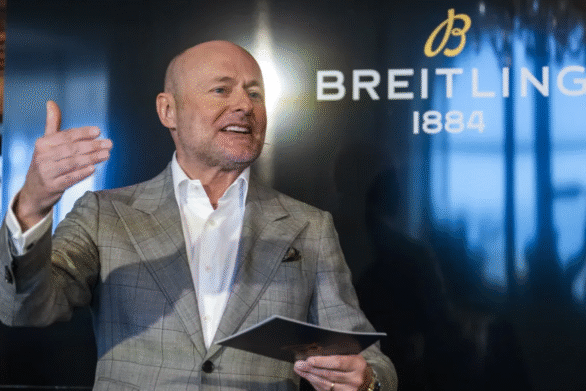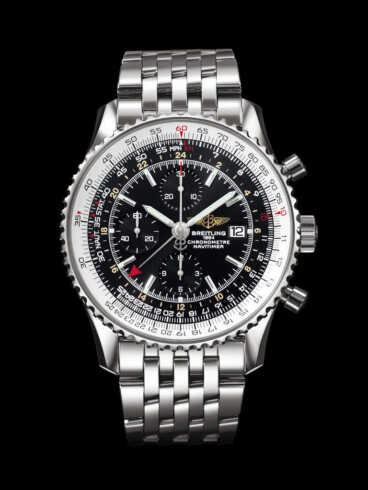Swiss watchmaking has been on edge ever since Washington shocked Bern with a steep 39% tariff on Swiss imports earlier this year – a level more associated with trade wars than with long-standing partners.
Now, in a sharp reversal, the United States has agreed to cut that import tariff to 15% as part of a new trade framework with Switzerland. In exchange, Swiss companies are expected to increase their investment footprint in the US over the coming years.
For an industry where the US is the single largest market, this is more than a technical adjustment. It is a reset of the risk profile for Swiss watches in America – and a development Canadian jewellers cannot afford to ignore.

Breitling’s Kern: “Team Switzerland” did its job
Breitling chief executive Georges Kern has been one of the most visible voices applauding the deal. He has framed the outcome as proof that “Team Switzerland” – government and industry lobbying together – still carries weight in Washington’s corridors of power.
At the same time, he has been clear-eyed about the limitations. Before the tariff shock, Swiss exports to the US typically faced low duties, often in the low single digits. Moving from 39% down to 15% is a huge improvement, but it still leaves the US market far more expensive at the border than it used to be.
Kern repeatedly underlines a key point: Swiss watches do not displace American manufacturing. Their appeal rests precisely on being “exclusively Swiss made”, which is exactly why US consumers seek them out. In his view, punishing that value proposition with punitive tariffs never made economic sense.
Despite a softer patch in demand during the autumn, he has linked the slowdown more to general uncertainty – including political and economic jitters – than to tariffs alone. Breitling is still planning for robust growth in the US, supported by its partnership with major sports properties, strengthened retail networks and focused brand building.

From 39% to 15%: what actually changes?
The new deal between Switzerland and the US does three crucial things for watchmaking:
- Cuts the tariff burden dramatically
On a US$10,000 watch at retail, a 39% tariff added nearly US$3,900 at the border. At 15%, that falls to around US$1,500. It is still a meaningful cost, but no longer a shock that forces brands and retailers into emergency pricing strategies. - Provides a clearer planning horizon
The agreement gives both sides a structure to work within over the next few years. While details still need to be finalized, brands can now plan production, pricing and allocation for the US on the basis of a more stable rate rather than a worst-case scenario. - Links tariffs to deeper economic ties
By tying the lower tariff to increased Swiss investment in the US, the deal reinforces a long-term partnership. For watch brands, that can translate into more local service centres, improved distribution hubs and enhanced marketing support in North America.
Even with these positives, the new 15% rate is not a return to the easy days of ultra-low duties. The industry still faces strong currency headwinds, high gold prices and a sense of “luxury fatigue” among some aspirational buyers. But the existential fear that the US market could become unaffordable at the border has eased.

The bigger picture: margins, pricing and allocation
The announcement of the 39% tariff triggered a surge of Swiss shipments into the US as brands and retailers rushed to clear inventory at the lower rate before the hike. Once the higher tariff came into force, they faced three unpleasant choices:
- Pass most of the cost on to consumers with sharp price increases.
- Absorb a significant share in already pressured margins.
- Redirect product to other markets where pricing could be adjusted more gently.
This happened against a backdrop of currency volatility and rising input costs. The decision to cut the tariff to 15% dramatically reduces the pressure for sudden double-digit price hikes in the US that would risk destabilizing global price coherence and fuelling grey-market arbitrage.
For names like Breitling, Rolex, Omega and other Swiss leaders, the new rate creates room to:
- Stabilize US retail prices relative to Europe and Asia.
- Protect brand equity by avoiding whiplash price moves.
- Re-focus commercial teams on client development instead of constant crisis management.
Where does Canada sit in this new landscape?
For Canadian jewellers, the key point is that Canada’s own tariff framework for Swiss watches has remained comparatively calm. Under trade agreements between Canada and EFTA countries, many Swiss industrial goods, including watches that meet rules-of-origin requirements, can enter Canada duty-free. Buyers still pay GST/HST and, where applicable, provincial sales tax, but there is no equivalent shock duty at the border.
In practical terms, that means:
- Swiss watches shipped directly into Canada often benefit from more predictable landed costs.
- The US, even after the cut, still faces a 15% import duty on Swiss products, which creates a structural cost gap between the two markets.
When you add currency movements, freight, insurance and sales taxes, the full picture is complex. But broadly, Canada now looks like a comparatively stable and predictable landing zone for Swiss watch inventory in North America.

What this could mean on the ground
Here is how the new US–Swiss tariff deal is likely to play out for Canadian retailers:
- Less risk of dramatic reallocation away from Canada
At 39%, brands were under intense pressure to rethink their US exposure and redirect some high-margin pieces to markets that were not being penalized as heavily. At 15%, that emergency pressure eases. Allocation decisions can be guided more by brand strategy and client demand than by tax-driven panic. - Stronger cross-border price narrative
With Canada enjoying long-standing tariff stability and the US settling at a higher baseline, Canadian retailers may find that headline prices on some models remain attractive compared to key US cities, especially once taxes and exchange rates are factored in. That creates an opportunity to capture incremental business from cross-border shoppers in major gateway markets. - A calmer pre-owned and grey-market environment
Sudden tariff-driven price spikes tend to turbo-charge the pre-owned segment, as buyers chase value and arbitrage opportunities. A move to 15% is still a premium, but it should reduce the incentive for speculative trading and help authorized retailers maintain a more orderly market. - More stable backdrop for launches and events
When executives like Kern can plan around a medium-term tariff rate, they are more likely to commit budgets to North American launches, boutique openings and experiential marketing. Canadian retailers often benefit from those halo investments through in-store events, regional roadshows and co-branded campaigns.
Action points for Canadian jewellers
Canadian Jeweller readers do not just need the news; they need a plan. Here are practical steps to consider:
1. Talk to your Swiss brand representatives
Open the conversation now about how the 15% US rate is influencing their North American price strategy, allocation and promotional planning. Ask whether any 2025–26 retail price adjustments are coming for your territory, and build your own communication and marketing calendar around them.
2. Update your sales team’s talking points
Clients will see headlines about “tariff cuts” and may assume US prices are dropping sharply. Equip your staff to explain, in simple terms, that:
- Canada’s tariff situation has remained stable.
- The US is moving from extremely high to still-elevated tariffs.
- Pricing is shaped by multiple factors: tariffs, currency, materials and long-term brand positioning.
3. Position Canada as a stable luxury hub
Use your own newsletters, social feeds and in-store messaging to emphasize Canada’s reputation for regulatory stability and quality-focused retail. For collectors who are tired of volatility and sudden policy shocks, that narrative carries weight.
4. Monitor changes in cross-border demand
Track the share of local versus tourist sales, and pay attention to any rise in US-based clientele as the new tariff regime settles in. If you notice more American buyers on Canadian shopping trips, be ready with targeted offers, concierge-style service and clear information about taxes and returns.
The takeaway: a rare piece of good news
It is not often that trade policy delivers a visible win for the luxury sector. The cut from 39% to 15% on US tariffs for Swiss imports does not take us back to the pre-crisis world, but it does remove a major threat from the horizon.
For Breitling and its peers, that means more energy to invest in product innovation, storytelling and retail partnerships instead of firefighting in Washington. For Canadian jewellers, it means operating in a North American market where the rules are clearer – and where Canada’s relative stability can be turned into a genuine advantage.
The global trade picture will continue to evolve, but for now, the direction is finally moving the right way for Swiss watchmaking – and for the Canadian retailers who bring those watches to local wrists.
![]()








